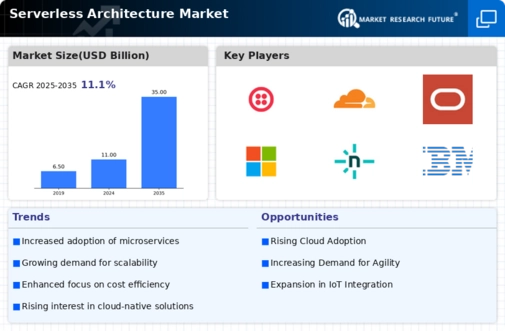Top Industry Leaders in the Serverless Architecture Market

Serverless Architecture Market: Dive into the Latest News and Updates
In the digital age, agility and innovation reign supreme. Businesses are ditching the cumbersome baggage of traditional servers and embracing the liberating world of serverless architecture. This report delves into the dynamic Serverless Architecture Market.
Some of Serverless Architecture Companies Listed Below:
- Rackspace Inc.
- Microsoft Corporation
- IBM Corporation
- CA Technologies
- Dell Boomi Inc.
- Joyent Inc.
- Platform9 Systems Inc.
- Amazon Web Services Inc.
- Manjrasoft Pty Ltd.
- Alibaba Cloud
- Twistlock
- Fiorano Software Inc.
- TIBCO Software Inc.
- Oracle Corporation
- Google LLC
Strategies Fueling Growth:
-
Cloud-Native Design: Serverless platforms built from the ground up for the cloud environment ensure scalability, flexibility, and seamless integration with other cloud services. -
Pay-Per-Use Pricing Model: Eliminating server management costs and only paying for actual code execution makes serverless attractive for cost-conscious businesses and experiment-driven startups. -
Focus on Developer Experience: User-friendly interfaces, comprehensive documentation, and readily available code samples simplify serverless application development and encourage adoption. -
Event-Driven Architecture: Building applications around events eliminates the need for continuous server operation, leading to improved efficiency and resource optimization.
Market Share Decoding: Key Factors to Consider:
-
Functionality and Feature Set: Platforms offering diverse function types (HTTP, event-driven, scheduled), advanced features like API gateways and stream processing, and integrations with various cloud services cater to complex application needs. -
Performance and Scalability: Ability to handle large volumes of requests, scale automatically based on workload, and maintain consistent performance is crucial for mission-critical applications. -
Security and Compliance: Robust security features, data encryption, and compliance with regulations like GDPR and HIPAA build trust and open doors to data-sensitive industries. -
Vendor Lock-In and Openness: Avoiding vendor lock-in through platform portability and open-source integrations ensures flexibility and future-proofs applications.
New and Emerging Stars: Illuminating the Serverless Path:
-
Serverless Containerization: Startups like Pulumi and OpenFaaS explore containerized serverless execution, combining the benefits of serverless with container portability and security advantages. -
Serverless Edge Computing: Companies like Edgemesh and Fastly push the boundaries of serverless to the edge of networks, enabling geographically distributed applications with ultra-low latency. -
Serverless Machine Learning: Startups like ServerlessML and Lambda Labs develop platforms for deploying and managing serverless machine learning models, simplifying AI integration into serverless applications.
Investment Trends: Where the Serverless Dollars Flow:
-
Next-Generation Serverless Platforms: Investors are backing companies developing cloud-native serverless platforms built for scalability, performance, and cost-effectiveness, catering to enterprises and mission-critical applications. -
Serverless and Edge Computing Convergence: Merging serverless with edge computing capabilities attracts significant investment, enabling decentralized applications with improved performance and reduced latency. -
Focus on Developer Tools and Workflow Automation: Startups providing tools for serverless development, testing, and monitoring secure funding for simplifying adoption and enhancing developer productivity.
Latest Company Updates:
November 10, 2023:
-
Amazon Lambda expands capabilities with support for containers: This update allows developers to package and deploy serverless functions in containers, increasing flexibility and portability. -
Microsoft Azure Functions introduces "Durable Functions" for stateful workflows: This new feature simplifies building long-running and stateful serverless applications.
December 5, 2023:
-
Focus on event-driven architectures: Serverless functions are increasingly triggered by events, streamlining application workflows and improving responsiveness.
January 7, 2024:
-
Security and compliance become top priorities: Serverless providers are offering enhanced security features and compliance certifications to address concerns about data privacy and governance. -
Hybrid and multi-cloud deployments gain traction: Businesses are looking for serverless solutions that work across multiple cloud platforms for increased flexibility and vendor lock-in avoidance.
January 9, 2024:
-
Serverless frameworks and tools simplify development and management: Open-source frameworks like Serverless Framework and tools like Lumigo are empowering developers to build and manage serverless applications more efficiently. -
Rise of serverless platforms for specific use cases: Serverless offerings tailored for AI/ML, IoT, and edge computing are emerging, further expanding the scope of serverless applications.









